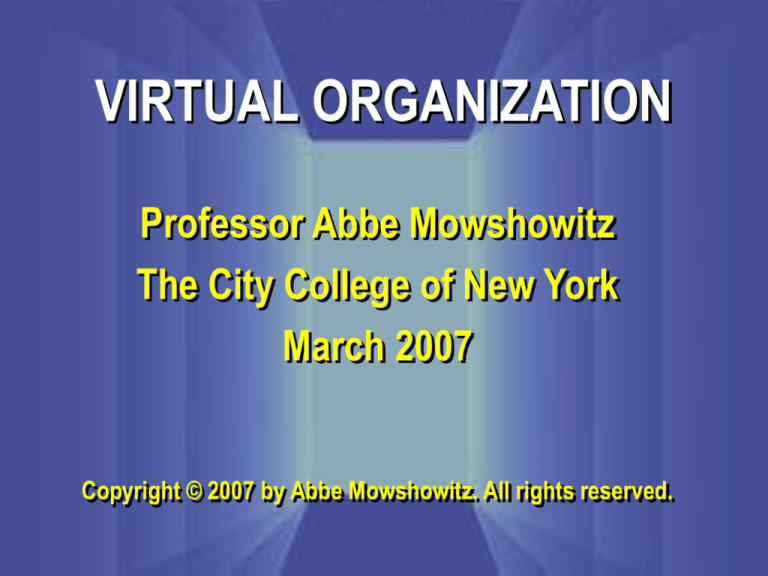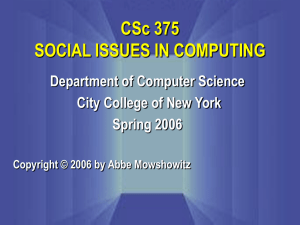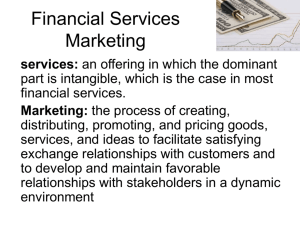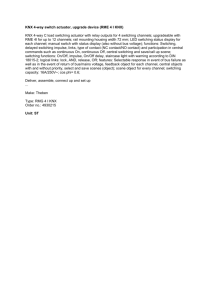
VIRTUAL ORGANIZATION
Professor Abbe Mowshowitz
The City College of New York
March 2007
Copyright © 2007 by Abbe Mowshowitz. All rights reserved.
A FIRST LOOK
Simple illustration of
virtual organization
SHIPPING DEPARTMENT
Services
• overnight
• three days
• one week
• two weeks
+ same day
- two weeks
Service Providers
• postal service
• inhouse courier
• UPS
• FEDEX
+ DHL
- inhouse courier
WAYS AND MEANS OF DELIVERY
overnight
postal service
three day
in house courier
one week
UPS
two weeks
FEDEX
UNIVERSITY DEPARTMENT
Services
• Intro (C++)
• Discrete Math
• Data Structures
• Software Design
+ Intro (JAVA)
- Intro (C++)
Service Providers
• Regular Staff
• Adjuncts
+ Adjuncts a,b,c
- Regular staff x
COURSES AND STAFF
introduction
regular staff
discrete math
data structures
software design
adjuncts
ADVANTAGES?
• Leveraged use of resources
• Cost savings (e.g., lower overhead)
• Greater flexibility
MANAGEMENT CHALLENGES
• Grasping the Potentialities of
Virtualizing Commercial Relations
• Planning for Change
Key: Virtual Organization
TECHNOLOGICAL SUBSTRATE
Transport
Computing
Telecommunications
GLOBAL NETWORKING
INFRASTRUCTURE
OUTLINE OF TALK
• Faces of virtuality
• A unifying definition
• Facilitators and impediments to
virtual organization
• Illustrations and experience
• Long Term Business Implications
FACES OF VIRTUALITY
•
•
•
•
Virtual Corporation or Enterprise
Virtual Office
Virtual Team
Virtual Classroom
FEATURES OF THESE FACES
• Organizations without walls
• Effective use of computer
communications
• Alliances and joint ventures
• Facilities moved at will over space
• Distributed organization of work
ABSENCE OF WALLS
SCIENTIFIC METHOD
“Simplest model is best.”
advises us to search for
UNDERLYING PRINCIPLE
RELATED CONSTRUCTS
• Virtual Memory (computers)
• Virtual Circuit (networks)
• Virtual Reality (multimedia)
COMMON TO ALL?
SPLIT BETWEEN NEEDS AND MODES
OF SATISFACTION
motivating the following
three-part definition
DEFINITION (PART 1)
A virtual organization is a goaloriented social unit operating under
metamanagement.
DEFINITION (PART 2)
Metamanagement is the management
of a virtually organized task.
• Analyzing abstract requirements
• Determining concrete satisfiers
• Tracking allocations
• Maintaining/revising allocation
procedure
• Reviewing satisficing criteria
DEFINITION (PART 3)
A virtually organized task consists of
(1) abstract requirements
(2) concrete satisfiers
(3) (re)allocation procedure (switch)
(4) ‘satisficing’ criteria
SWITCH
THE SWITCH ASSIGNS SATISFIERS TO
REQUIREMENTS
ACCORDING TO THE SATISFICING
CRITERIA
SWITCHING COMPLEMENTS
ESTABLISHED PRACTICES
Division of labor/specialization of
function
– task simplification
– combinational flexibility
EFFICIENCY (Adam Smith)
CHEAPER LABOR (Charles Babbage)
CRITICAL MANAGEMENT
ELEMENTS
•
•
•
•
•
•
Abstract requirements
Concrete satisfiers
Assignment of satisfiers to requirements
Tracking assignments
Switching
Satisficing criteria
LIMITATIONS OF SWITCHING
• Excessive switching can nullify
gains
• Advantages limited by analogue
of thrashing in virtual memory
systems
CRITICAL INNOVATIONS
INCORPORATION OF SWITCHING
IN MANAGEMENT PRACTICE
&
AUTOMATED DECISION SUPPORT
RELATION TO FAMILIAR MODELS
• Generalizes classical matching
methods such as personnel
assignment and resource allocation
• Requirements and satisfiers are
fixed in classical methods and little
or no switching is involved
CLASSICAL MATCHING METHOD
TASKS
WORKMEN
DYNAMIC FEATURES OF
METAMANAGEMENT
•
•
•
•
Requirements can vary
Satisfiers can vary
Procedures can vary
Systematic switching is supported
GENERIC EXAMPLES
of virtual organization
AUTOMOBILE ASSEMBLY
SATISFICING
CRITERIA:
cost-quality
relationship
SWITCHING:
change suppliers
COMPONENTS
SUPPLIERS
TAX MANAGEMENT
SATISFICING
CRITERIA:
minimize overall
taxes
SWITCHING:
shift obligations
between plants
TAX OBLIGATIONS
OBLIGATION PER PLANT
PORTFOLIO MANAGEMENT
SATISFICING
CRITERIA:
maximize risk
return
SWITCHING:
substitute
investment
INVESTMENT TYPES
SPECIFIC INVESTMENTS
HIGH TECH HELP DESK
SATISFICING
CRITERIA:
maximize satisfactioncost ratio
SWITCHING:
substitute service
provider
CLIENT SERVICES
SERVICE PROVIDERS
GENERAL OBSERVATIONS
• Switching model is applicable to a
wide range of management
problems
• Major advantages in cost and
flexibility can be achieved
CASE STUDY OF DISTRIBUTED
NETWORK: VIRTUAL FACTORY
• Experience of Two Networks of
Engineering Firms
• Bodensee Region of Switzerland
• Northwest & Central Switzerland
BODENSEE
•
•
•
•
•
•
Thirty Member Firms (2002)
Centralized Structure
Limited Liability Corporation
Assist in Acquiring New Business
Configure Groups for Projects
Fee Based Project Management
NORTHWEST & CENTRAL
•
•
•
•
•
•
Forty Member Firms (2002)
Decentralized Structure
Association Charter under Swiss Law
No Dedicated Representative
Each Member Represents Association
Reliance on Standing Committees
ABSTRACT VIEW
Requirements
• project types
Satisfiers
• subsets of firms
(e.g., making
machine, or
component)
(e.g., member firms
a, b and c form
joint venture)
+ new type
- existing type
+ new subset
- existing subset
SUCCESS AND FAILURE
Bodensee
Northwest & Central
• ill-defined function
of central office
• lack of trust among
member firms
• individual interest
• membership
deemed of marginal
value
• members represent the
network
• association promotes
smooth interaction
• collective interest
• membership deemed
worthwhile
SUCCESS FACTORS
• Commitment of member firms to
network
• Shared protocols for cooperation
• Willingness to share experience
• Global sensitivity to membership
and markets
PITFALLS
• Insistence on centralized
management functions
• Absence of shared protocols
• Too little attention paid to
consensus building
WHAT MAKES VIRTUAL
ORGANIZATION WORK?
PAST: ALL IN ONE
FUTURE: ONE IN ALL
INFORMATION COMMODITIES
STANDARDIZATION
FINANCIAL INSTRUMENTS
will evolve as
FACILITATORS OF
VIRTUAL ORGANIZATION
PAVING THE WAY TO VIRTUAL
ORGANIZATION
• Build information commodities
• Promote standardization
• Create appropriate financial
instruments
INFORMATION COMMODITIES
• Goods or services furnishing
information
• Computer-based types: software,
databases
• Elements of information markets
COMPUTER-BASED
INFORMATION COMMODITIES
HAND/BRAIN TO COMPUTER
INFORMATION MARKETS ARE TO
VIRTUAL ORGANIZATION
what
LABOR MARKETS WERE
TO THE FACTORY SYSTEM
INFORMATION MARKETS
UNDERWRITE:
• Computer-based alternatives to
human-borne knowledge
• Lower costs
• Greater flexibility
STANDARDIZATION
• Technical
– access (Wireless Application Protocol)
– information exchange (XML based EDI)
– interaction (conferencing protocols)
PROTOCOLS FOR
ELECTRONIC COMMERCE
STANDARDIZATION
• High level business protocols
INTERCHANGEABILITY OF
ORGANIZATIONAL PARTS
(‘socionomics’ and ergonomics)
SOCIAL PROTOCOLS: COSTUME
Soldier, Farmer, Laborer, Merchant
FINANCIAL INSTRUMENTS
• Exchange
– online payments
– electronic wallets
• Financial management
– derivatives
– hedging strategies
• Tools for building new instruments
e.g., securitization
BASIC SECURITIZATION
LAND
PLANT
EQUIPMENT
SHARES (in concrete assets)
HIGHER LEVEL
SECURITIZATION
LEASES/SHARES
MUTUAL FUNDS
SHARES (in abstract assets)
CURRENT PRACTICES
• Outsourcing (‘cut & paste’)
– products and services
– labor
• Inventory Management
– just in time
– quick response
• Electronic brokerage
– customer order management
– logistics management
GLOBAL OUTSOURCING
SWITCHING IN E-COMMERCE
•
•
•
•
•
Bizbuyer.com
Profiles submitted by Vendors
Vendor coverage: equipment &
services
Buyers submit Request for Proposal
Vendors selected to receive RFP
Client notified if vendor bids on RFP
E-BROKERAGE
SATISFICING
CRITERIA:
meet specs at
minimal cost
SWITCHING:
substitute
subset
REQUEST TYPES
SUBSETS OF VENDORS
COST-EFFECTIVE BROKERAGE
• Gather Information about vendors
and potential buyers
• Update databases
• Maintain allocation procedure
COMPONENTS OF
SWITCHING COSTS
COSTS OF VIRTUAL
ORGANIZATION
• No free lunch
• Toward a taxonomy of costs
NO FREE LUNCH
MAXWELL’S DEMON
DEMON
WORKS
TRAP
DOOR
HIGH
VELOCITY
CHAMBER
LOW
VELOCITY
CHAMBER
DEMON COST
ENTROPY DECREASE
equals
DEMON INFORMATION
DIVISION OF LABOR
Adam Smith’s pin factory
INCREASE IN PRODUCTIVITY
THROUGH TASK
RESOLUTION AND REDUCTION OF
SKILL REQUIREMENTS
DIVISION OF LABOR COST
PRODUCTIVITY GAINS
partially offset by
SUPERVISORY OVERHEAD
VIRTUAL ORGANIZATION
ADVANTAGES
limited by
SWITCHING AND HUMAN COSTS
SWITCHING COSTS
• Assignment of new satisfier to
requirement
– transaction (e.g., accounts and database
changes)
– legal (i.e., new contracts)
– interfaces (e.g., new systems)
• Requirements analysis and satisfier
scanning
ACCOUNTING
• Switching benefits must exceed
cost of re-assignment
– not trivial to determine
– dedicated activity is needed
– include in switching costs
• Amortize costs over lifetime of
need-satisfier pairing
RESEARCH IN PROGRESS
• Investigation of scientific methods
for implementing the functions of
metamanagement
• Empirical studies of costs and
benefits of switching
• Development of guidelines to assist
organizations in exploiting the
potential of switching
voSWITCH
LONG-TERM BUSINESS
IMPLICATIONS
CLAIM
Virtual Organization Will Prove
Irresistible to Managers
because
People Act in What They Perceive to Be
Their Best Interests
and
The Competitive Advantage of Virtual
Organization Will Become Apparent
BALANCE SHEET
• Advantages
– efficiency and effectiveness
– responsiveness and flexibility
• Disadvantages
– costs (intelligence, switching)
– human relations (weaker ties)
REQUIREMENTS OF SWITCHING
• Ease of forming, modifying and
terminating relationships (‘coupling
and decoupling’)
– person to person
– person to organization
– organization to organization
• Mobility
FACILITATING SWITCHING
TRANSFORMATION OF TRUST AND
LOYALTY
ANONYMITY: FOCUS ON MUTUAL
ADVANTAGE
LOYALTY
Traditional: subjective
BASED ON AFFECT
Post-modern: objective
BASED ON COMMON INTEREST
TRUST
Traditional: static
LINKED TO SOCIAL STATUS AND
GROUP MEMBERSHIP
Post-modern: dynamic
LINKED TO JOB FUNCTION AND
ORGANIZATIONAL AFFILIATION
CONDITIONS OF INTERACTION
Homogeneity
(reliability ensured by
authority and custom)
Diversity
(reliability ensured by
standardization)
COEXISTENCE OF NEW AND OLD
STANDARDIZATION NEED NOT
ELIMINATE RELIANCE ON
AUTHORITY AND CUSTOM
metamanagement can partition
its sphere of action
VIRTUALITY REINFORCES
FRAGMENTATION
• Decline of nation state power
• Devolution of power and authority
onto ‘private’ organizations
EMERGING POLITICAL ECONOMY
• Power and authority centered in
virtual organizations
• Political power and authority
exercised by private organizations
• Economic power based on globally
distributed resources
VIRTUAL FEUDALISM
CONCLUSION
• Virtual organization offers
competitive economic advantage
• Managers who ignore it do so at the
peril of their companies
• A new world of business and
government is in the making




![Network Technologies [Opens in New Window]](http://s3.studylib.net/store/data/008490270_1-05a3da0fef2a198f06a57f4aa6e2cfe7-300x300.png)




